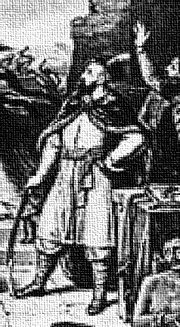
Jan Samuel Chrzanowski
Encyclopedia

He was a member of the Polish bourgeois, he began his military career in the regiment of Stanisław Koniecpolski. In 1673 he fought at Chocim
Battle of Khotyn
Battle of Khotyn can refer to several battles that took place near Khotyn:* Battle of Khotyn * Battle of Khotyn...
, that same year he gained the rank of captain. From 1674 he served in the regiment of Aleksander Niezabitowski, from 1675 the regiment came under the ownership of Jan Cetner, the starost of Szczurowice.
During the Polish-Turkish war
Polish-Ottoman War (1672–1676)
Polish–Ottoman War or Second Polish–Ottoman War was a war between the Polish-Lithuanian Commonwealth and the Ottoman Empire, as part of the Great Turkish War. It ended in 1676 with the Treaty of Żurawno and the Commonwealth ceding control of most of its Ukraine territories to the...
in 1675, a 30,000 strong Turkish army aided by Tartars led by the Sultan Serder's son in law Ibrahim Szyszman, invaded present day Ukraine. After conquering Zbaraż (July 27, 1675) and Podhajec (September 11, 1675) about 10,000 soldiers of the Turkish army arrived in Trembowla. The town of Trembowla
Battle of Trembowla
The Battle of Trembowla, more popularly known as the Defense of Trembowla, was glorified and immortalized in the paintings of Franciszek Smuglewicz, Józef Peszka and Aleksander Lesser. In 1675 the Turkish army destroyed the town of Trembowla, in the Podole Voivodship, and laid siege to the castle...
was destroyed, but the castle, which was defended by about 80 soldiers, a handful of nobleman and around 200 peasants, all led by Jan Samuel Chrzanowski, withstood the Turkish armies advances for over two weeks. On October 11, 1675 the Turkish army withdrew its forces upon hearing that Polish forces led by the Polish King Jan III Sobieski
John III Sobieski
John III Sobieski was one of the most notable monarchs of the Polish–Lithuanian Commonwealth, from 1674 until his death King of Poland and Grand Duke of Lithuania. Sobieski's 22-year-reign was marked by a period of the Commonwealth's stabilization, much needed after the turmoil of the Deluge and...
were nearing. In a camp near Buczacz
Buchach
Buchach is a small city located on the Strypa River in the Ternopil Oblast of western Ukraine...
King Sobieski gave Chrzanowski the rank of lieutenant colonel.
Chrzanowski's acts of bravery became famous in all of Poland, and in 1676 he was asked to stand before the Polish-Lithuanian Commonwealth
Polish-Lithuanian Commonwealth
The Polish–Lithuanian Commonwealth was a dualistic state of Poland and Lithuania ruled by a common monarch. It was the largest and one of the most populous countries of 16th- and 17th‑century Europe with some and a multi-ethnic population of 11 million at its peak in the early 17th century...
's Sejm
General sejm
The general sejm was the parliament of Poland for four centuries from the late 15th until the late 18th century.-Genesis:The power of early sejms grew during the period of Poland's fragmentation , when the power of individual rulers waned and that of various councils and wiece grew...
wherein he became nobilitized under the coat of arms of Poraj, while also receiving a reward of 5,000 złoty.
From 1676 he became the commandant of Lwów. From 1682 he was the Podstoli
Podstoli
Podstoli was a court office in Poland and Lithuania. A Podstoli was the deputy of a Stolnik, and was responsible for the King's pantry....
of Mielnic.

